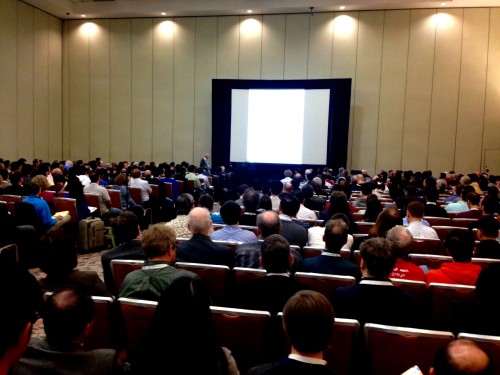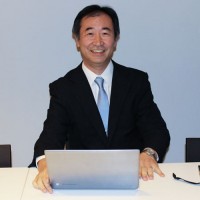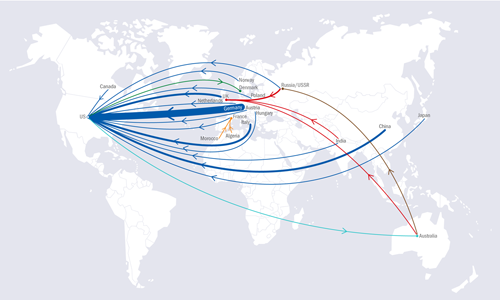Tag archives: Nobel prize
Would you encourage your grandchildren into condensed-matter physics?

Packed in: a full room for Anthony Leggett’s talk. (Courtesy: Tushna Commissariat)
By Tushna Commissariat in Baltimore, Maryland, US
One of the most popular talks this morning at the APS March meeting was almost certainly given by Nobel-prize-winning physicist Anthony Leggett of the University of Illinois at Urbana-Champaign in the US. Leggett, who shared the 2003 Nobel Prize for Physics for his work on superconductors and superfluids, talked about his “Reflections on the past present and future of of condensed-matter physics”.
As the abstract of his talk suggests, Leggett looked at the ways, means and even the very definition of “condensed-matter physics” has changed and “evolved since its inception in the early 20th century, with particular reference to its relationship to neighbouring and even distant disciplines”. He went on to “speculate on some possible directions in which the discipline may develop over the next few decades, emphasizing that there are still some very basic questions to which we currently have no satisfactory answers”.
I missed the beginning of his talk as I was attending the morning’s first set of press briefings (more on those later) but when I did walk into the packed hall for his talk, his slide had the rather interesting title: “Would I encourage my grandchildren to go into condensed-matter physics?” Happlily enough, his answer at the end of his talk was a resounding “yes”.
How to win a Nobel prize
By Hamish Johnston

Eureka moment: Takaaki Kajita’s Nobel journey began when he was improving software. (Courtesy: Takaaki Kajita)
This morning I had the pleasure of speaking with Takaaki Kajita, who shared this year’s Nobel Prize for Physics. He won for discovering that some of the muon neutrinos produced by cosmic-ray collisions in the atmosphere change flavour as they travel to Earth. This phenomenon, called neutrino oscillation, tells us that neutrinos have mass – something that was not initially included in the Standard Model of particle physics.
From his office at the University of Tokyo, Kajita told me that the story began in 1986 when he was working on a proton-decay experiment at the Kamioka underground lab in Japan. He was trying to improve some software that was designed to discriminate between electrons and muons created within the detector. He noticed that there were fewer events associated with muon neutrinos than expected. Muon neutrinos are created in the atmosphere when cosmic rays collide with air molecules and a possible explanation for the deficit was that some of the muon neutrinos were oscillating into electron neutrinos on their journey to the detector. Looking back, however, Kajita told me that his initial reaction to the deficit was that he must have made a mistake in his analysis.
View all posts by this author | View this author's profile
Weighing up the options for neutrino mass
By Tushna Commissariat
As I am sure all of you know, the 2015 Nobel Prize for Physics was awarded yesterday to Arthur McDonald and Takaaki Kajita “for the discovery of neutrino oscillations, which shows that neutrinos have mass”. Following on from yesterday’s neutrino-flavoured excitement, here’s an explanation of why it’s so important that we better understand neutrino mass.
Our current observations and theories of neutrino oscillations suggest that at least two of the currently known three flavours of neutrinos have non-zero mass. While we know the mass differences between the different neutrino flavours accurately, their actual masses have not been measured. It’s not for lack of trying, it has simply proven very difficult to make the measurements.
View all posts by this author | View this author's profile
And the winner is: our 2015 Nobel-prize predictions

Psychic world: we have another go at predicting the Nobel winners. (Courtesy: iStockphoto/shutter_m)
By Tushna Commissariat and Hamish Johnston
Update: Looks like we were quite spectacularly wrong this time around with our predictions as this year’s Nobel has been awarded to Arthur McDonald and Takaaki Kajita “for the discovery of neutrino oscillations, which shows that neutrinos have mass”. While Physics World’s news editor Michael Banks did predict this in 2013, we did not think this would be the year. Clearly, as our “Which physics disciplines attract the most Nobel prizes” infographic suggests, the field of particle physics still seems to be the most Nobel-worthy one.
It’s a mug’s game, we know, but come the start of October we just can’t resist trying to predict who will win the Nobel Prize for Physics, which this year will be announced on Tuesday 6 October.
With the exception of 2013 – when most pundits were right in thinking that the prize would be related to the 2012 discovery of the Higgs boson – predicting the next Nobel winners (or winners) is a tough call. If you want to take an analytical approach, check out the infographic we published last year: “Which physics disciplines attract the most Nobel prizes”. It suggests that the field of atomic, molecular and optical physics is due a prize, and one of us (Hamish Johnston) thinks an excellent bet is Deborah Jin for her work on fermionic condensates. If Jin were to win, she would be only the third woman ever to win a physics Nobel – the other two being Marie Curie in 1903 and Maria Goeppert-Mayer in 1963.
New infographics show that more than one-quarter of physics Nobel laureates are immigrants

Migration of minds: maps showing the movement of Nobel laureates (click to see full infographic). (Design: Paul Matson)
By Hamish Johnston
Next Tuesday the Nobel Prize for Physics will be announced at 11:45 CEST and I am making the bold prediction that the winner – or one of the winners – will be an immigrant. Why? Because this year’s Physics World Nobel-prize infographics show that of the 198 people who have won the prize, 51 are immigrants – so I reckon there is a reasonable chance that I will be right.
What do we mean by an immigrant? This is a tough question, especially in science, where people tend to move around a lot and don’t always settle in one place. For the purposes of these infographics, we have used a rather crude definition of an immigrant laureate: someone who died or currently lives in a country other than that of their birth. There is more about how we made the infographics later in this post – but first, what do they tell us?
View all posts by this author | View this author's profile
Physicists in motion: immigration and the Nobel prize

Around the world: how has immigration shaped the global physics community? (Courtesy: iStockphoto/Joel Carillet)
By Hamish Johnston
In December 1938 Enrico Fermi travelled to Stockholm, where he was presented with that year’s Nobel Prize for Physics for his insights into the atomic nucleus. But after the ceremony, Fermi did not return to his native Italy. Instead, he joined his wife and young children on a voyage to the US. Fermi went on to make major contributions to physics in that country – including playing crucial roles in developing nuclear weapons and nuclear energy.
View all posts by this author | View this author's profile
Light lunch with a Nobel prize winner

Lunchtime chat: Shuji Nakamura (right) in conversation with Scott Rosenfeld.
By Robert P Crease in New York
I seldom go to the Javits Center, New York City’s big, ugly convention space where the food, drinks and parking are way overpriced. Its shows on fashion, furniture and food don’t interest me and it’s a 20-minute walk from the nearest subway station. I once heard comedian Seth Meyer quip that it’s “smack-dab in the middle of New York’s stabbing district”.
On Sunday I went for the first time in years to attend the inaugural lunch of LIGHTFAIR, the world’s largest lighting trade show that draws architects, engineers and designers from all over the world. The featured speaker was Shuji Nakamura, the Japanese-born American materials scientist who shared last year’s Nobel in physics for developing the blue LED. Nakamura described his research path – when he started virtually everyone was working on selenium and he said he chose gallium only because he thought it would make it easier to publish – and was joined on stage by Scott Rosenfeld of the Smithsonian American Art Museum.
Celebrating a year of light

Shuji Nakamura talks to delegates about blue light-emitting diodes.
By Michael Banks in San Antonio, Texas
With 2015 being the International Year of Light it is perhaps the perfect opportunity to have a session at this year’s American Physical Society meeting in San Antonio dedicated to the forefront of optics research.
Yesterday afternoon saw a number of light pioneers update delegates about their research. The session boasted three of last year’s Nobel-prize winners: Stefan Hell of the Max Planck Institute for Biophysical Chemistry in Gottingen, Germany; William Moerner of Stanford University; and Shuji Nakamura of the University of California, Santa Barbara.
Blood Moons, teachers who moulded the minds of great physicists and more

Jocelyn Bell Burnell on her high-school physics teacher. (Courtesy: Perimeter Institute for Theoretical Physics)
By Tushna Commissariat
This week has been an exciting and busy one at Physics World HQ, what with two Nobel prizes that included physics – the actual Nobel prize for physics, of course, as well as this year’s chemistry Nobel, which was given to three physicists. Since last week’s Red Folder was full of Nobel trivia and facts, I will only point you to two more interesting Nobel-related articles. The first is an excellent article on the Slate website, by one of our regular freelance authors Gabriel Popkin, where he looks at female physicists who deserve a Nobel. His list is in no way exhaustive, but does well to highlight some excellent work done by women that deserves recognition, so do take a look at “These women should win a Nobel prize in physics”. Also, Ethan Siegel from the Starts With a Bang! blog has written an excellent essay to silence any would-be naysayers about the worthiness of giving the Nobel to the researchers who developed blue LEDs. In “Why blue LEDs are worth a Nobel Prize”, he outlines the history of LEDs and talks about just how many applications they have in today’s times.
View all posts by this author | View this author's profile
Nobel mania – predictions, discussions, hangouts and more
By Tushna Commissariat
In this week’s Red Folder, we are looking at all things Nobel-prize-related, as the winner(s) of the 108th Nobel Prize for Physics will be announced in Stockholm next Tuesday.
Kicking off the Nobel round-up is our own infographic that tells you what branch of physics you should take up if you are keen to become a laureate yourself. In case you haven’t seen it already, take a look at it here and work your way through our seven categories that encompass all 107 physics Nobel prizes handed out to date.
Next, watch the video above where the Smithsonian Magazine’s science editor Victoria Jaggard hosts a Google Hangout to discuss the science and scientists predicted to win this year’s award. In it, she talks with Charles Day of Physics Today, Andrew Grant of Science News, Jennifer Ouellette of Cocktail Party Physics and Amanda Yoho of Starts With A Bang!, as they discuss everything from topological conductors to graphene to neutrinos.
View all posts by this author | View this author's profile